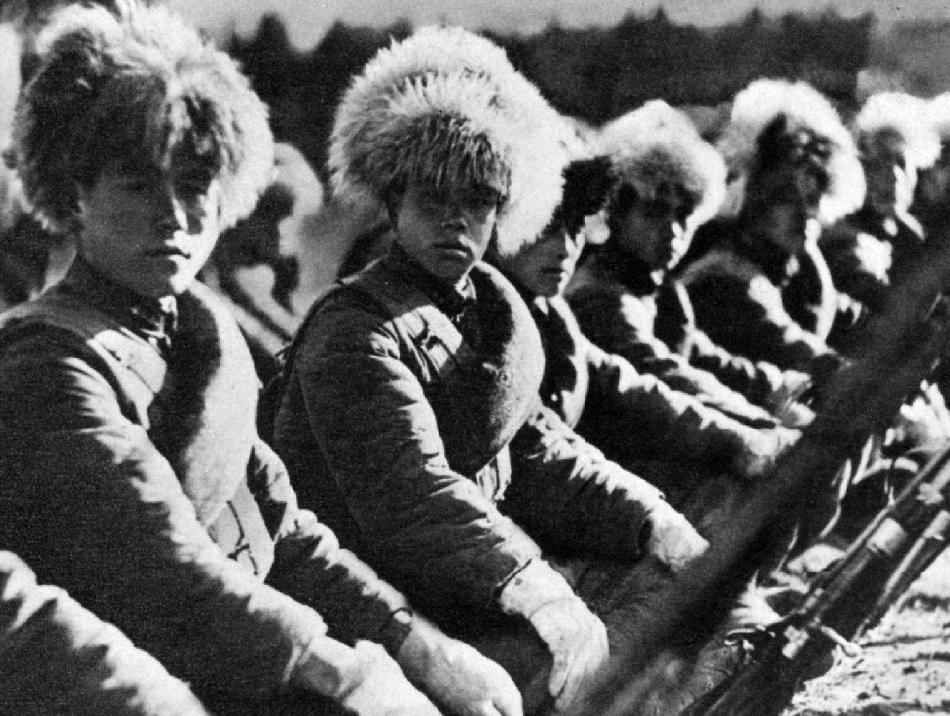
Japanese Imperial Army Formations: The Kwantung Army

Figure 1.-- The Kwantung Army during the inter-War era was an anomaly in the rigidly hyerarchial Imperial Japanese Army (IJA). It had a degree of autonomy permitted nowhere else. It became the most prestigious formation in the IJA. Many important Jazpanese world war II figures built careers based on their service in the Kwantung Army. Primeminister Tojo commanded the Kempeitai (secret police) of the Kwantung Army.
|
|
The Manchurian/Mukden Incident began with an explosion along a sectio of the Souh Mnchurian Railway on the night of September 18, 1931. he explosion was created as a pretext for invasion by officers of the Japanese Kwantung Army acting indpendently from the autorities of the Government in Tokyo. "It had been planned by two realtively junior officers without the auhorty of the Government in Tokyo, but within the space of about 5 to 10 days they managed to occupy large parts of a region about the size of France and Germany combined. So this was really one of the most daring miliary actions that has been seen in the 20 century."
-- Professr Rana Mitter, Professor of Modern Chinese History, Oxford University.
The Imperial Japanese Army (IJA) had one of the most rigid command structures of any World War II military. An anomaly here was the Kwantung Army (KA). This it of enormous importance because it was largely the actions of the KA that led Japan into first Manchuria (1931) and then China (1937). Many of these actions were initiated by the KA without even consulting the Japanese Government or evem the IJA. Both would, however, support the KA's unauthorized actions. They would even supportthe KA when they took on the soviet Red Army. And the the war with China which of course morphed into the Pacific War with the United States.
The Liáodōng Peninsula, once referred to as Southeast Manchuria in the West, is one of the most importnt strategic prominances in the Yellow sea, situated at the conjunction of China, Manchuria, and Korea. It has been fought over since ancient times, including the war States Period. The Japanese began to move into the Liáodōng Peninsula during the First Sino-Japanese War (1894-95). The desire to control the Peninsula and Port Arthur (Lüshun) resulted in the Russo-Japanse War (1904-05). The Japanese victory opened up further intoads into Manchuria. The Japanese established a garison at Kwantung to guard the Southern Manchurian Railway from bandits, Chinese war lords, and rival countries. Kwantung was a coastal territory on the Liaodong Peninsula including the ports of Dalian and Lüshun.
After World War I the Japanese had significant territorial ambitions in East Asia, including Mnchuria and Siberia. As part of this expanonist desires, the Japanese formed the KA from their alreasy existing Kwantung Garrison and it became an official IJA formation. The KA became doiminated by young, highly nationalistic young officers who essentially privatized the command structure. They became the most prestigious IJA formation in the inter-War era. The autonomy of the KA appaled to young officers seeking to make their names. It was the only IJA formation involved in acual, if low-level, fighting. The region became very important ecomically and became a boom area where Manchurian food harvests and raw materials were tansported for shipment to the expanding industries on the Home Islands. The KA soldiers were often aggressive and entirely disdainful of both Japanese and Chinese civilian authority. The KA operated as border police and railway guards. The control of the railway provided opportunities for illegal, but lucratibe gains such as involvemnt in opium trading. The young officers were contemptuous of the Japanese Government's perceived diplomatic concessions on military matters, such as the Washingon Naval Conference as well as deferal on the implementation of the Twenty-One Demands on China. KA soldiers were aggressive and commonly just ignored both Chinese and Japanese civilian authorities. They began to use the phrase, 'loyal insubordination'. And througout the 1920s the KA became increasingly violent. Not only did the KA often operate indepdedently of the IJA High Command, but often groups of officetrs in the KA made decisions on their own. One such group assassinated a Manchurian warlord that stood up to them (1928). They placed a bomb on his personal railcar. and it was not just the Chinese they targeted. There were confrontations along the Soviet border (mid-1920s). And it was the KA that staged an incident on the railline that led to the Japanese seizure of Manchuria (1931). This is often cited as the first aggrssion leading to World War II. KA units were also involved in the Marco Polo Bridge incident launching the Japanese invasion of China proper (1937). The history of the KA is murky because the officers involved commonly operated secretly in small groups. And as the actions they took were often illegal, not to mention oranized crime like opium traficking, no one was overly enthusiastic to write memoirs after the disaterous war in which they played a major role in laubching. In addition with the Red Army invasion of Manchuria (April 1945) many of the individuals involved disappeared into the Soviet Gulag.
Sources
CIH -- WW II

Navigate the CIH World War II Section:
[Return to Main Khalkhin Gol page]
[Return to Main Victory of the Japanese Army Strike South Faction page]
[Return to World War II Manchuria]
[Return to Main World War II Japanese Road to War page]
[Return to Main Imperial Japanese Army page]
[Return to Main Japanese World War II page]
[Return to Main Tripartate Pact page]
[Biographies]
[Campaigns]
[Children]
[Countries]
[Deciding factors]
[Diplomacy]
[Geo-political crisis]
[Economics]
[Home front]
[Intelligence]
[Resistance]
[Race]
[Refugees]
[Technology]
[Bibliographies]
[Contributions]
[FAQs]
[Images]
[Links]
[Registration]
[Tools]
[Return to Main World War II page]
[Return to Main war essay page]
Created: 3:16 AM 9/11/2015
Last updated: 12:56 PM 2/22/2025



